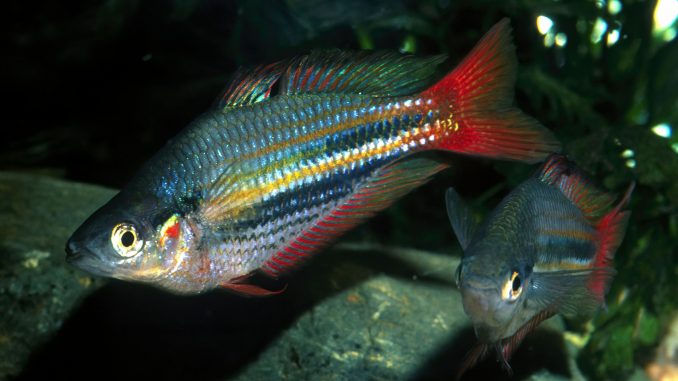
Rainbowfish are popular aquarium fish because they are beautiful to look at and easy to take care of. All species of rainbowfish belong to the Melanotaeniidae and Pseudomugilidae families, of which there are several rainbowfish subfamilies and genera.
Rainbowfish are native to North and South Australia, New Guinea, Madagascar, Indonesia, and Sulawesi, and they come in many different colors, prints, and body types.
TABLE OF CONTENTS
Rainbowfish Body Type: Oval
These species of rainbowfish have rounder, fuller body shapes. The main section of their body between the head and the anal fin is shaped like an oval.
Banded Rainbowfish
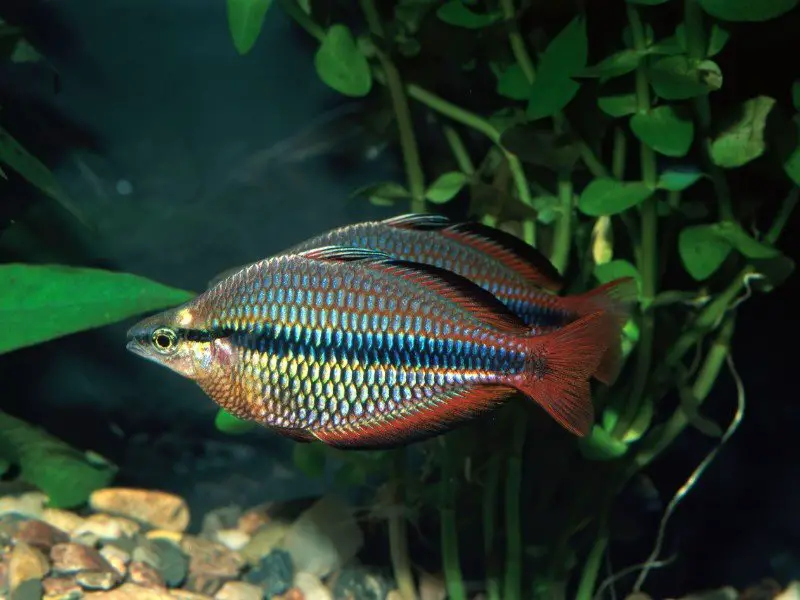
| Care level: | Temperament: | Color: | Lifespan: | Size: |
| Moderate | Peaceful | Yellow, blue, green, red, or orange | 5–8 years | 6 inches |
| Water temperature: | Water pH: | Tank size: | Diet: | Scientific name: |
| 73–80°F | 6.5–8.0 | 55 gallons | Omnivore | Melanotaenia trifasciata |
Banded rainbowfish are from the Melanotaeniidae family, and are popular in aquariums because of their bright colors and their placid nature. These rainbowfish are native to swamps, rivers, lagoons, and lakes in North Australia.
Adult banded rainbowfish have wide bodies with brightly-colored anal, dorsal, and caudal fins, and a dark mid-lateral stripe. Male banded rainbowfish have wider bodies and brighter colors than females. Males also have a humped forehead, and females don’t.
Key Care Information:
- Group banded rainbowfish in same-species shoals of six to eight fish. Banded rainbowfish also live well with other peaceful shoaling species like guppies and neon tetras.
- Banded rainbowfish prefer well-vegetated tanks with plenty of driftwood, roots, gravel/sand substrate, and 55 gallons of swimming space for six to eight fish.
- Higher pH levels, between 6.5 and 8.0, cause brighter colors in banded rainbowfish.
- Banded rainbowfish are prolific breeders all year round. Bloodworms and brine shrimp encourage breeding behavior in banded rainbowfish. It’s best not to keep multiple males together because they’re territorial and can become aggressive.
- Banded rainbowfish eat a variety of freeze-dried, frozen, and live foods.
Boesemani Rainbowfish
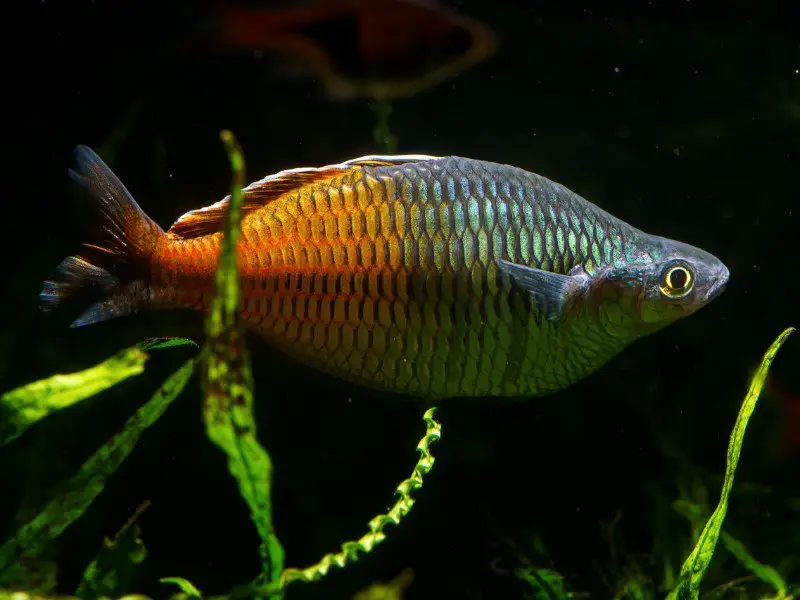
| Care level: | Temperament: | Color: | Lifespan: | Size: |
| Easy | Peaceful | Blue and red/orange | 5–8 years | 4.5 inches |
| Water temperature: | Water pH: | Tank size: | Diet: | Scientific name: |
| 81–86°F | 7.0–8.0 | 30 gallons | Omnivore | Melanotaenia boesemani |
Boesemani rainbowfish are from the Melanotaeniidae family, and are popular in aquariums because of their social nature, easy care level, and astonishing color division.
These rainbowfish are brightly colored tropical fish with blue heads and red/orange tails. Their contrasting colors meet in the middle and are divided by the dorsal fin. Male and female boesemani rainbowfish bodies are both oval-shaped, and both genders have short fins.
Boesemani rainbowfish originate in the Ayamaru Lakes in Indonesia.
Key Care Information:
- Group boesemani rainbowfish with same-species schools of six to eight fish. Boesemani rainbowfish are social and blend well with other peaceful shoaling fish, including zebra danios and cory catfish.
- Decorate the Boesemani rainbowfish tank with dense vegetation, rocks, debris, and sand substrate.
- Boesemani rainbowfish breed well in the right conditions. A temperature of 82°F and a pH level of 7.5 encourages breeding behavior. Male boesemani rainbowfish display a stripe on their heads when they’re ready to reproduce.
- Feed Boesemani rainbowfish tiny insect larvae and small plant matter. Boesemanis eat anything in small quantities.
Bleher’s Rainbowfish
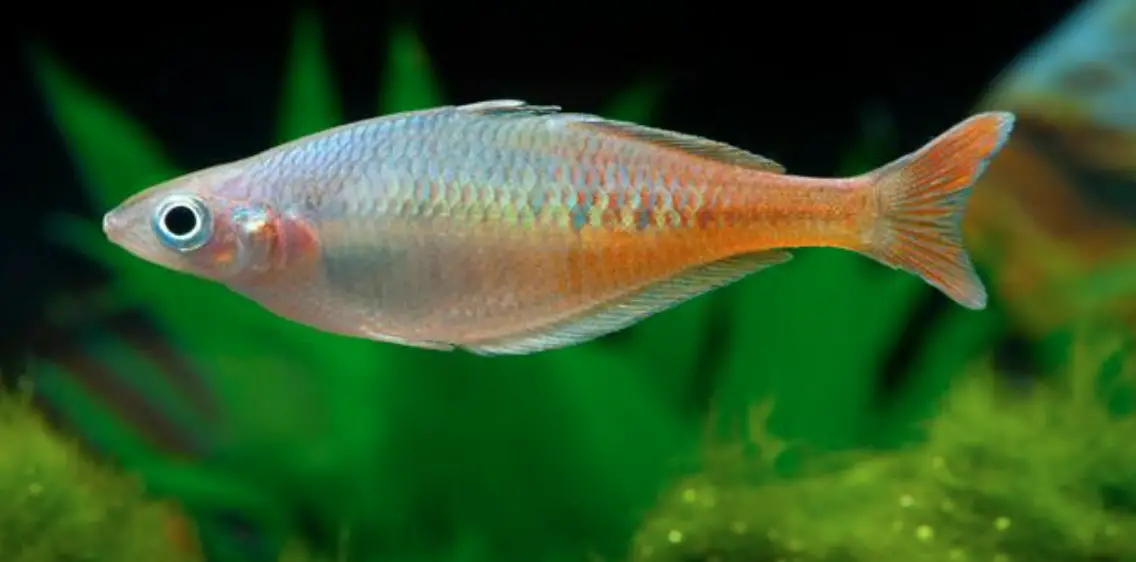
| Care level: | Temperament: | Color: | Lifespan: | Size: |
| Moderate | Peaceful | Silver or bluish-gray that fades into orange/red | 8–12 years | 4.7 inches |
| Water temperature: | Water pH: | Tank size: | Diet: | Scientific name: |
| 73–91°F | 6.8–7.8 | 30 gallons | Carnivore | Melanotaenia boesemani |
This species of rainbowfish is popular in aquariums because of its bright colors and social nature.
Adult male Bleher’s rainbowfish have a silver or bluish-gray head that fades in color into bright yellow, orange, and red toward the tail. Adult female Bleher’s rainbowfish are whiter and more translucent than males, with more drab, faded colors toward the tail.
Bleher’s rainbowfish are from the Melanotaeniidae family. The Bleher’s rainbowfish got its name from a German Botanist named Heiko Bleher, who discovered the new species of fish with Gerald Allen in 1982 and named it in 1985.
The Bleher’s rainbowfish originates in the shallow rivers surrounded by jungle and abundant plant life at the foothills of Lake Holmes in Indonesia.
Key Care Information:
- Group Bleher’s rainbowfish with same-species schools of six to 10 fish. Bleher’s rainbowfish are social and blend well with other shoaling fish, including various rainbowfish and peaceful barbs.
- Decorate the Bleher’s rainbowfish tank with floating plants, rocks, gravel substrate, and provide them with plenty of swimming space. A 30-gallon tank for 10 fish is plenty.
- Breeding Bleher’s rainbowfish is easy. Breed in a separate tank that is decorated with marble substrate, java moss clumps, and delicate leafy plants. Remove the breeding pair of Bleher’s rainbowfish from the tank after they spawn so they don’t eat the fry. Keep the eggs and the fry in the breeding tank.
- Feed Bleher’s rainbowfish live and frozen brine shrimp, bloodworms, daphnia, and mosquito larvae.
Lake Kutubu Rainbowfish

| Care level: | Temperament: | Color: | Lifespan: | Size: |
| Moderate | Peaceful | Blue, teal, silver, yellow, and cobalt | 5–8 years | 5 inches |
| Water temperature: | Water pH: | Tank size: | Diet: | Scientific name: |
| 70–79°F | 8.5–9.0 | 30 gallons | Carnivore | Melanotaenia lacustris |
Lake Kutubus are known for their ability to change color within just a few seconds, which makes them popular in aquariums.
The adult fish, especially the males, are bright blue and teal with a yellow underbelly, and a cobalt blue stripe along both sides. Juvenile Lake Kutubu rainbowfish have long bodies that mature into a wider shape.
Lake Kutubu rainbowfish are from the Melanotaeniidae family, and they originate from Lake Kutubu and the Kikori River in Papua New Guinea.
Key Care Information:
- Group Lake Kutubu rainbowfish in same-species schools like to be in groups of 6–10 fish. Lake Kutubu rainbowfish are social and blend well with danios, gobies, and corydoras.
- Decorate the tank of Lake Kutubu with bogwood, lots of rooted plants, and a sand substrate. Provide a tank big enough for them to swim freely. Thirty gallons per 10 fish is enough swimming space.
- Lake Kutubu rainbowfish breed well in a separate tank with fine-leaved plants and a spawning mop. Pair two female Lake Kutubu rainbowfish with three males and feed them plenty of live and plant-based foods to encourage spawning.
- Lake Kutubu rainbowfish eat flakes, pellets, bloodworms, fish, shrimps, and plant material.
Neon Rainbowfish

| Care level: | Temperament: | Color: | Lifespan: | Size: |
| Moderate | Peaceful | Iridescent blue with orange/red/yellow fins | 3–5 years | 2–3 inches |
| Water temperature: | Water pH: | Tank size: | Diet: | Scientific name: |
| 72–79°F | 6.5–8.0 | 20 gallons | Omnivore | Melanotaenia praecox |
Neon rainbowfish are popular for their incandescent colors and social behavior. Neons have wide bodies with iridescent blue scales and colorful fins. Male neon rainbowfish have wider bodies than females, and red fins, while females have narrow bodies and yellow/orange fins with silver trimming.
This species of rainbowfish goes by other names too, including peacock rainbowfish, dwarf neon rainbowfish, praecox rainbowfish, and diamond rainbowfish.
Neon rainbowfish are from the Melanotaeniidae family, and they originate from the Mamberamo River Basin in Indonesia.
Key Care Information:
- Group neon rainbowfish in same-species schools of 10 or more. Neon rainbowfish are social and blend well with other peaceful shoaling fish like freshwater gobies and cichlids.
- Decorate the neon rainbowfish’s tank with lots of vegetation, bogwood, and a sandy substrate. Neon rainbowfish are skilled jumpers so they require a tight-fitting aquarium lid.
- Neons breed well in a separate tank with delicate leafy plants and a spawning mop. Encourage spawning by feeding the pair a healthy diet of bloodworms, shrimp, and plant food. If not kept in an independent tank, neon rainbowfish crossbreed and lose their colors.
- Feed neon rainbowfish brine shrimp, bloodworms, lettuce, peas, and pellets.
Red Irian Rainbowfish

| Care level: | Temperament: | Color: | Lifespan: | Size: |
| Easy | Peaceful | Red or olive | 6–8 years | 6 inches |
| Water temperature: | Water pH: | Tank size: | Diet: | Scientific name: |
| 70–79°F | 6.5–8.5 | 30 gallons | Omnivore | Glossolepis incisus |
Red rainbowfish are from the Melanotaeniidae family and are also commonly known as red Irian rainbowfish, salmon-red rainbowfish, or New-Guinea rainbowfish. They’re popular with aquarists because of their bright color.
Male red rainbowfish are bright red with a high rounded back. Females have lower backs with a silver body that shines yellow and olive green. Juveniles resemble female red rainbowfish. Males have silver lines over their backs and midsections.
Red rainbowfish originate from the densely vegetated Tami river and Lake Sentani in Western New Guinea.
Key Care Information:
- Group red rainbowfish in same-species schools of six to ten fish. Red rainbowfish are social with other peaceful shoaling fish and invertebrates like shrimp and snails.
- Decorate the red rainbowfish’s tank with bogwood, rocks, lots of plants like jungle val, and a mix of sand and gravel substrates.
- Red rainbowfish breed well in a dedicated tank with fine vegetation, where the females drop their eggs. Raise the temperature to 79°F in the breeding tank and introduce the fastest pair of red rainbowfish.
- Red rainbowfish eat flakes, pellets, insects, floating vegetation, bloodworms, and brine shrimp.
Rainbowfish Body Type: Slim
While these types of rainbowfish also have oval-shaped bodies, their body shape is elongated and thinner. Their bellies have a slim shape, unlike the fuller bellies of the oval rainbow fish.
Celebes Rainbowfish
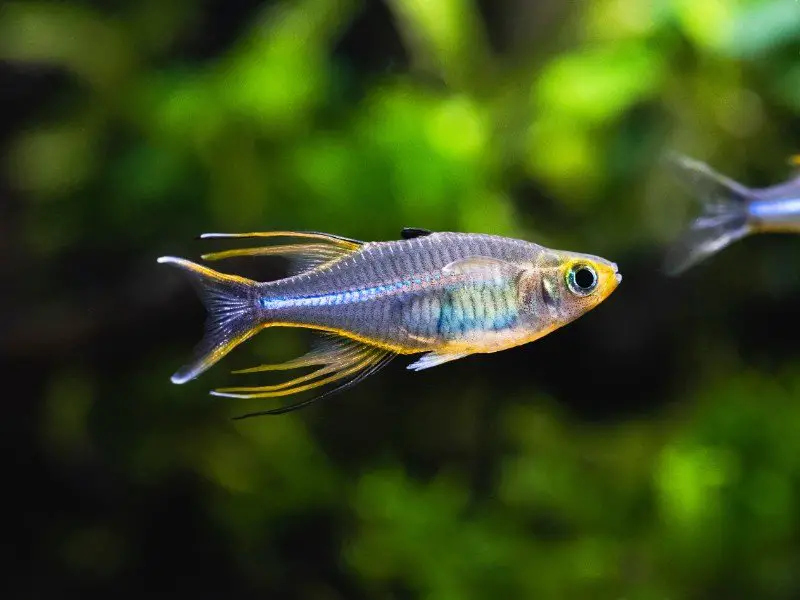
| Care level: | Temperament: | Color: | Lifespan: | Size: |
| Moderate | Peaceful | Translucent with blue and gold tinges | 3–5 years | 3.2 inches |
| Water temperature: | Water pH: | Tank size: | Diet: | Scientific name: |
| 72–82°F | 7.0–8.0 | 20 gallons | Omnivore | Marosatherina ladigesi |
Celebes rainbowfish are from the Telmatherinidae subfamily of the Melanotaeniidae family. They are a popular rainbowfish species because of their colorful displays and unique fin shapes. These small, translucent rainbowfish have two dorsal fins and are slenderer than other rainbowfish.
The celebes’ pectoral fin tips are black or translucent, and the larger dorsal fin has a yellow or golden tinge. Male celebes rainbowfish have thread-like extensions from the fins, and the shape of the fins differs from fish to fish.
Celebes originate from brackish estuaries and fast-flowing rivers on the island of Sulawesi in Indonesia.
Key Care Information:
- Group celebes rainbowfish in same-species schools of eight to 10 fish. Celebes rainbowfish are social and pair well with other rainbowfish that can live in the same aquatic conditions as the celebes.
- Decorate the celebes rainbowfish tank with plenty of vegetation including floating plants, and provide 20 gallons of swimming space for 10 fish.
- Celebes rainbowfish breed well in water temperatures between 72 and 74°F with a pH level of 7.5 and no substrate. Female celebes rainbowfish become plumper and males become more aggressive before breeding. Remove the eggs as well as the fry immediately so adult celebes won’t eat them.
- Feed celebes dried or live insects, plants, and worms.
Desert Rainbowfish

| Care level: | Temperament: | Color: | Lifespan: | Size: |
| Moderate | Peaceful | Females are silver/transparent, males are blue-green or purple/yellow-green | 5 years | 3.5–4 inches |
| Water temperature: | Water pH: | Tank size: | Diet: | Scientific name: |
| 76–86°F | 6.2–8.0 | 30 gallons | Omnivore | Melanotaenia splendida tatei |
Desert rainbowfish are from the Melanotaeniidae family. These rainbowfish are popular because they are active and fun to watch, and aquarists enjoy the male desert’s bright colors.
Both male and female desert rainbowfish are smaller than other rainbowfish, and they have a metallic shine that changes as they dart around. However, males and females have different coloring. Male desert rainbowfish are blue-green, or purple with yellow-green fins. Female rainbowfish have a silvery body with transparent fins. Juvenile rainbowfish resemble females.
Desert rainbowfish originate from waterholes, stock dams, and ephemeral rivers in Queensland and New South Wales, Australia.
Key Care Information:
- Group desert rainbowfish in same-species schools of eight to 10 fish. Desert rainbowfish are social and blend well with other color variations of desert rainbowfish or desert gobies.
- Decorate the desert rainbowfish’s tank with gravel substrate, and plenty of vegetation. Desert rainbowfish are jumpers and require a tank with a tight lid.
- Desert rainbowfish breed during warmer months. When ready to breed, mature females have transparent fins, and adult male desert rainbowfish have a pink tinge that appears on the fins.
- Feed desert rainbowfish a meaty diet that includes insect larvae and brine shrimp.
Forktail Rainbowfish
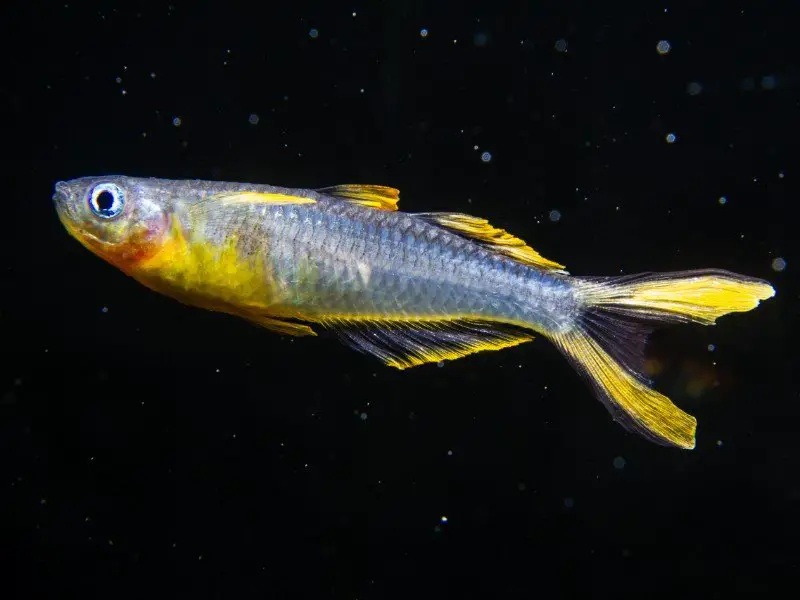
| Care level: | Temperament: | Color: | Lifespan: | Size: |
| Easy | Peaceful | Blue eyes, silver body with bright yellow stripes | 3 years | 2.5 inches |
| Water temperature: | Water pH: | Tank size: | Diet: | Scientific name: |
| 75–79°F | 7.0–8.0 | 30 gallons | Omnivore | Pseudomugil furcatus |
Forktail rainbowfish are from the Pseudomugilidae family, and originate from the Peria Creek and Kwagira River in Papua New Guinea. These silvery, blue-eyed, forktail rainbowfish are popular because fishkeepers enjoy watching the brightening of the fish’s colors during the breeding season.
The male forktail rainbowfish has sharp, curvy dorsal and pectoral fins during the breeding season. Female and juvenile forktail rainbowfish have yellow fins and lines at the bottom and top of their bodies, and they are paler than male fish.
Key Care Information:
- Group forktail rainbowfish in same-species schools of six to eight fish. Forktail rainbow fish are social and blend well with other peaceful community fish like rasboras and danios.
- Decorate the forktail rainbowfish tank with driftwood, plenty of rooted plants, river rocks, and a sandy substrate.
- Forktail rainbowfish breed between the ages of eight and 15 months. After 15 months to about 1 year, the male’s chest will protrude more than usual. This pigeon chest means that the male is too mature to be bred. Breeding tanks must be well-vegetated with fine, feathery plants.
- Feed forktail rainbowfish micropellets, Daphnia, baby brine shrimp, and cyclops.
Madagascan Rainbowfish
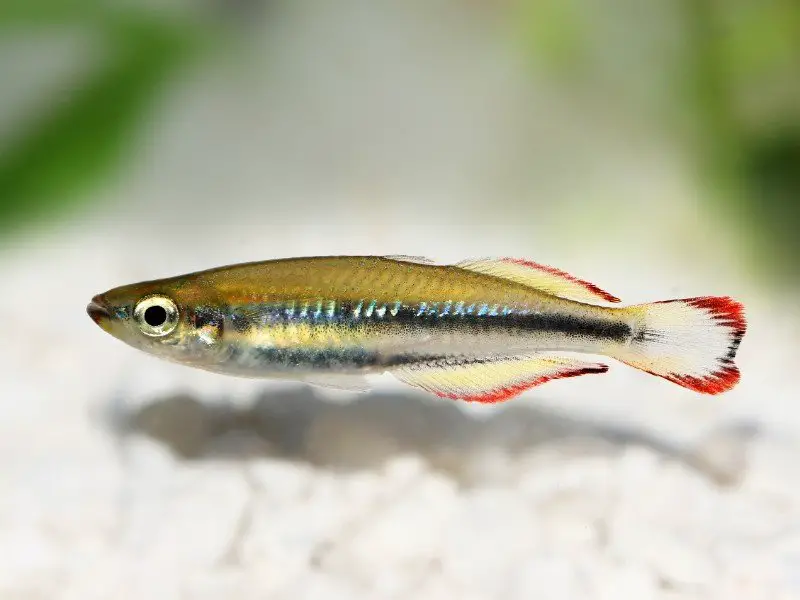
| Care level: | Temperament: | Color: | Lifespan: | Size: |
| Easy | Peaceful | Silver with a rainbow hue and brown/yellow tint | 5–11 years | 5.9 inches |
| Water temperature: | Water pH: | Tank size: | Diet: | Scientific name: |
| 73–84°F | 5.0–7.0 | 30 gallons | Omnivore | Bedotia madagascariensis |
Madagascan rainbowfish are from the Bedotiidae subfamily of the Melanotaeniidae family, and are popular for their brilliant colors and social nature. These fish originate from the clear, shaded streams in the Canal des Pangalanes along the coast of Madagascar.
The Madagascan rainbowfish has a long, slender body and a short but powerful dorsal fin. This species of rainbowfish is silver with a rainbow hue that shines either yellow-brown or blue. The fish has bright yellow fins with a dark golden tail.
Male Madagascan rainbowfish have more brilliant fins and tails than do the female fish.
Key Care Information:
- Group Madagascan rainbowfish in same-species schools of six to eight fish. Madagascans are social and blend well with characins and peaceful cichlids.
- Decorate the Madagascan rainbowfish’s tank with lots of rooted plants, rocks, and a dark substrate combination of sand and gravel. The lid must fit tightly to prevent the fish from jumping out of the tank.
- Breed Madagascan rainbowfish in a separate tank with slightly acidic, hard water, and a stronger current. A sponge filter and fine-leaved plants encourage spawning.
- Feed Madagascan rainbowfish water fleas, bloodworms, brine shrimp, and algae wafers.
Threadfin Rainbowfish
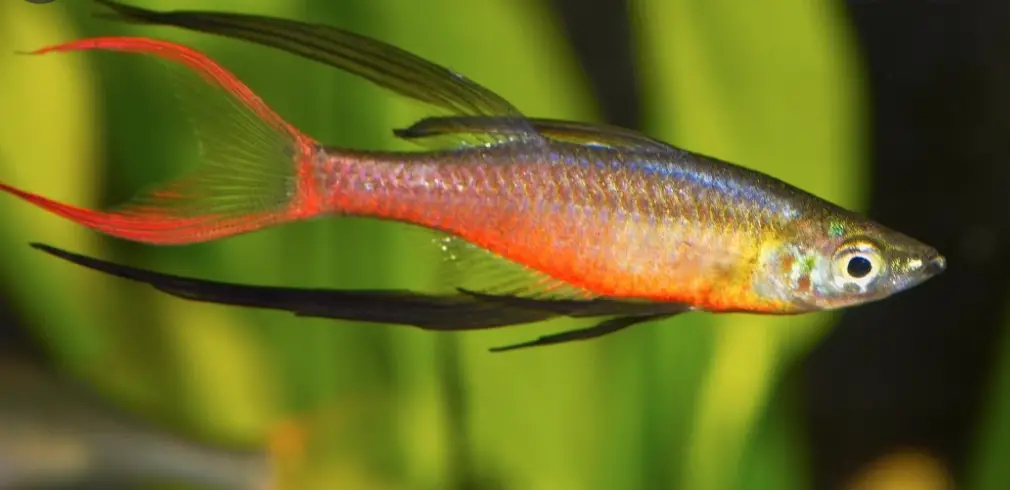
| Care level: | Temperament: | Color: | Lifespan: | Size: |
| Moderate | Peaceful | Silver with blue and orange hues | 3–5 years | 2 inches |
| Water temperature: | Water pH: | Tank size: | Diet: | Scientific name: |
| 77–86°F | 5.2–7.5 | 15 gallons | Omnivore | Iriatherina werneri |
Threadfin rainbowfish are from the Melanotaeniidae family, and are popular among aquarists because both males and females are brightly colored. Threadfins originate from the tropical waters of Northern Australia and Papua New Guinea.
Threadfin rainbowfish are small and have long, slim bodies. Male threadfin fish are silver with blue top hues and orange bottom hues. They have faint vertical stripes with dark or bright orange/red tails and dorsal fins.
Female threadfin rainbowfish have translucent fins and silver bodies with honey or green hues.
Key Care Information:
- Group threadfin rainbowfish in same-species schools of no more than six fish with a ratio of two females to every male. Threadfin rainbowfish are social and blend well with shrimp, snails, and other rainbowfish.
- Decorate the threadfin rainbowfish’s tank with various rooted and floating plants like water wisteria, plenty of driftwood, hornwort, and a mix of sand and gravel substrates.
- Threadfin rainbowfish breed well during warmer months. Encourage spawning in a designated tank that is decorated with a spawning mop and java moss. Keep temperatures at 78°F and feed the parents live foods like shrimp and mosquito larvae.
- Threadfin fish eat diatoms, crushed flakes, mosquito larvae, and brine shrimp.
Choosing & Caring For Different Types of Rainbowfish
Rainbowfish are colorful, popular fish among aquarists, and are easy additions to community tanks. Breeding various types of rainbowfish is simple with the right conditions, and the fish thrive among other peaceful shoaling species.
You can house different color forms of the same species of rainbowfish together. You shouldn’t keep different species together, because they are likely to interbreed, which muddles the gene pool and spoils the many diverse wild species available today.
Choose a colorful combination of same-species rainbowfish to house together in a home aquarium. Just be sure that each fish agrees on water temperature and pH levels.

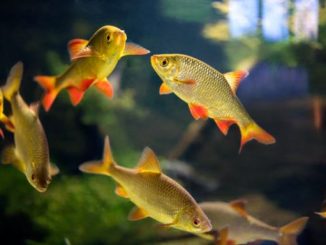
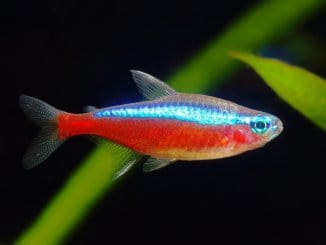
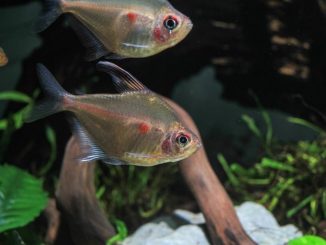
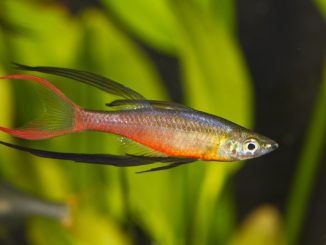
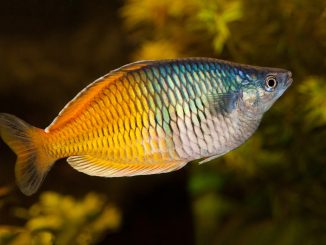
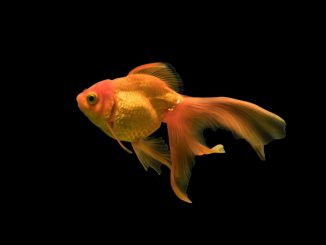
Be the first to comment